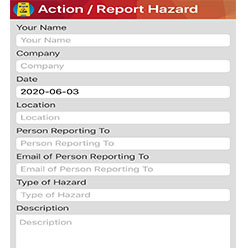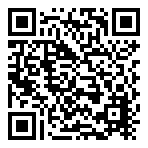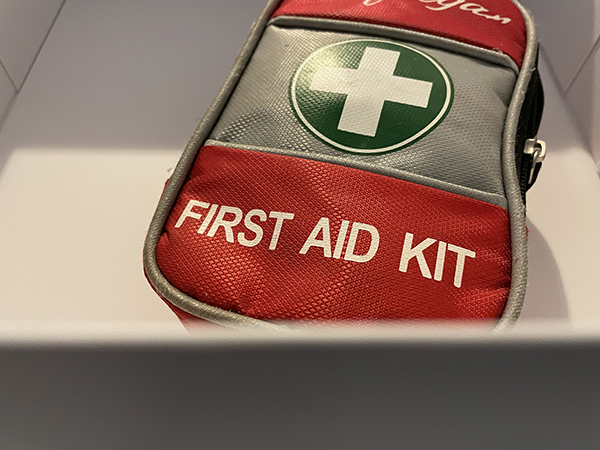Incident Report Forms >>
Published 17/01/2022
HAZARD REPORTING SYSTEM: BEST PRACTICE HAZARD REPORT SOFTWARE
 Best practice hazard reporting software starts with real time hazard management of hazards that are discovered in the workplace or existing known hazards. A comprehensive hazard report system consists of a hazard report registry, hazard risk control and a real-time hazard report form. A registry of all workplace hazards enables your staff to track, acknowledge and understandard the risks of working safely in the workplace while exposed to those hazards. All staff should have the ability to both report new hazards they are involved with or witness or to be able to access a real-time registry of all current hazards in their specific workplace environment.
This might be a part of your wider safety management platform.
Best practice hazard reporting software starts with real time hazard management of hazards that are discovered in the workplace or existing known hazards. A comprehensive hazard report system consists of a hazard report registry, hazard risk control and a real-time hazard report form. A registry of all workplace hazards enables your staff to track, acknowledge and understandard the risks of working safely in the workplace while exposed to those hazards. All staff should have the ability to both report new hazards they are involved with or witness or to be able to access a real-time registry of all current hazards in their specific workplace environment.
This might be a part of your wider safety management platform.
Here we walk through the best setup and design for a hazard reporting system and how to transform existing hazard report forms into online and mobile ones for truly real-time hazard reporting in the workplace for your staff, contractors and visitors.
View Hazard Templates, Forms and Examples

Hazard Reporting Registry
A Hazard Report registry should be real-time. What was once a hazard historically, might not be any more and what has only just been discovered as a workplace hazard, might be critical to bring awareness to all staff, contractors and visitors in the workplace who might not be at risk of a safety incident if exposed to that workplace hazard.
A typical hazard register might consist of fields such as:
- Hazard Report Type
- Location / Site
- Date reported
- Exact location
- How the hazard could cause harm
- How it was identified
- Risk controls
- Risk Rating
Example Hazard Report Form
Try scanning the QR code!

Designing a Hazard Report Form
The hazard report form might have two sides to it, one might be reactive where it is in relation to an incident report that has been reported. In this scenario the hazard report form is looking at the hazards that led to the injury or incident. It might then look at the risks and actions relating to the identified hazards and how to prevent a similar incident from happening again.
An proactive hazard report might be more around new hazards that are observed or encountered in the workplace by staff, contractors or visitors and ensuring that these are captured and identified so that they can then be managed in the workplace.
Hazard Risks
When looking at the risks for hazard reporting, fields might include:
- Is the Current Risk Level Acceptable?
- Likelihood
- Consequence
- Risk Rating
- Identifying the underlying cause of this hazard
- Risk Control
BEST PRACTICE HAZARD REPORTING SETUP
Here is a breakdown of the four core elements to include when setting up a hazard reporting software system:
Live Hazard Report Forms
Enable all staff, contractors and employees to have the ability to report any type of hazard they encounter or observe. Create a positive hazard reporting culture in your workplace
|
|
Registry
Real time hazard report registry that has both historical hazards and active ones with information on how to work safely with them.
|
|
Identify the hazard type and causes
Not just logging the hazard existence but classifying it by type and identifying its causes
|
|
Generate Reporting and Metrics
Deep dive into hazard reporting causes and trends in the workplace
|

CREATE YOUR OWN HAZARD REPORT FORM
Move away from paper based forms and move to mobile hazard reports. Ensure everyone has the ability to report a hazard in your workplace. Do your staff and contractors have the ability to directly do this in their own words right now?
If you need something ready to go, we've also got a library of templates too!
HAZARD REPORTING PLATFORM
Try out the demo above and see how your hazard incident report form process looks via our dedicated hazard reporting platform.
 Best practice hazard reporting software starts with real time hazard management of hazards that are discovered in the workplace or existing known hazards. A comprehensive hazard report system consists of a hazard report registry, hazard risk control and a real-time hazard report form. A registry of all workplace hazards enables your staff to track, acknowledge and understandard the risks of working safely in the workplace while exposed to those hazards. All staff should have the ability to both report new hazards they are involved with or witness or to be able to access a real-time registry of all current hazards in their specific workplace environment.
This might be a part of your wider safety management platform.
Best practice hazard reporting software starts with real time hazard management of hazards that are discovered in the workplace or existing known hazards. A comprehensive hazard report system consists of a hazard report registry, hazard risk control and a real-time hazard report form. A registry of all workplace hazards enables your staff to track, acknowledge and understandard the risks of working safely in the workplace while exposed to those hazards. All staff should have the ability to both report new hazards they are involved with or witness or to be able to access a real-time registry of all current hazards in their specific workplace environment.
This might be a part of your wider safety management platform.


